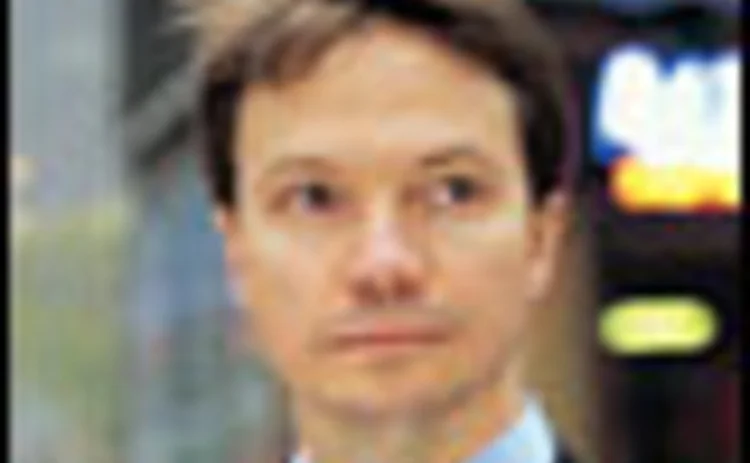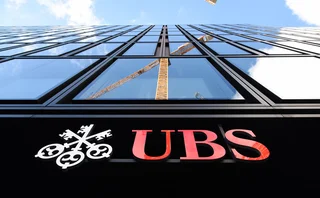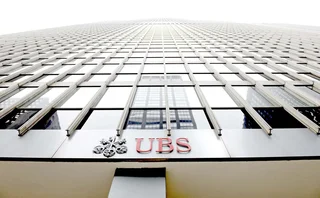
Peter Abramenko
A man renowned for playing his cards close to his chest, Peter Abramenko, managing director at UBS Principal Finance, gives US Credit a tantalizing glimpse of his philosophy on credit investing and reveals who’s to blame for the market’s volatility problems. Laurence Neville reports

Although most people would not admit it, almost everyone has at some time ‘Googled’ themselves. Typing your own name on the internet search engine will usually yield a few results – maybe a conference you have been to, a paper you might have written, or at the very least a high school reunion you have attended.
That Peter Abramenko, managing director at UBS Principal Finance, generates only one correct response is illuminating. Even more revealing is that the response concerns an article in which he declined to comment. This is an organization and an individual that does not like publicity. In person, Abramenko lets little more slip. Specific questions about the hedge fund’s funding, strategy, and structure are brushed aside with a “no comment”.
But at the same time, Abramenko is a familiar name to many on the Street. After roughly two decades working in corporate bonds, he has earned a place among the elite that elicits respect within the relatively small and sometimes ignored credit market. Ever since Abramenko moved to set up what is in all but name a hedge fund, other credit market participants have wondered what he is doing.
So what exactly does Principal Finance do? Abramenko is not at liberty to say what specific strategies and asset classes it uses or even how many people it employs. It was tough to get him to admit that the fund is based out of New York. Eventually, when pushed, Abramenko reveals that the fund’s objectives are to look for arbitrage and other opportunities as a total rate of return-oriented investor. Its aim is also to “outperform” – although Abramenko would not be drawn on what it is benchmarked against.
Outlook
However, in the course of the conversation some of Abramenko’s strategies became clearer. First, where his personal outlook on investing is concerned, he says he has been able to navigate the treacherous market because he refuses to follow a single approach.
“Because dramatic shifts in the market paradigm can occur from month to month, it’s dangerous to be wedded to any strategy for a prolonged period of time. As a result, our approach to the market and our portfolio trading strategies have changed markedly over the past three years and will be changing again going into 2004.”
In 2002, negative market psychology and technicals outweighed long-term credit fundamentals in many sectors such as telecoms and electricity generation, and as a result dictated a much greater emphasis on distressed debt and liquidity analysis than the investment-grade market had ever encountered, according to Abramenko. At the moment and continuing into 2004, the unit’s emphasis has shifted to relative-value trading strategies which are better suited to a credit market where price is governed by longer-term sector and credit fundamentals – as is usually the case during economic upswings.
According to Abramenko, in addition to determining longer-term fundamental valuations, analysts and portfolio managers must also look at other factors affecting a security’s valuation. This cherry-picking approach to strategies reflects what Abramenko calls an “incrementalist” view on credit. “It’s extremely risky to rely solely upon long-term equilibrium valuations of sectors and securities in making total rate of return portfolio decisions,” he says.
High levels of short- and medium-term market volatility mean that even if an investor makes the right credit or sector call, they may not survive long enough to see the eventual outcome. “Markets and specific securities can remain very under- or overvalued for extended periods of time relative to their long-term equilibrium value. The key to surviving the total rate of return game is to adopt an incrementalist approach,” he says.
“For example, if an investor bought Telus bonds in June 2002 when they were trading at 85 cents on the dollar, they would have been buying at a very attractive purchase price compared with their longer-term value, ie where they trade today. But unfortunately the telecom market meltdown got so much worse that at the market bottom a month later, the investor could have bought the same bonds for only 45 cents on the dollar – 40 points lower!” While the fundamental analysis of the credit was eventually proven correct, unlike Abramenko’s incrementalist approach, it could not predict the impending collapse in the bond’s price resulting from panicked market psychology and abysmal technicals.
Abramenko reckons that his experience on the sell side during the 1980s and 1990s has helped him in this capacity on the buy side. “Understanding market equilibrium is invaluable. It’s not just about the fundamentals that drive issuance and relative value but about issuer, investor, and dealer psychology. It’s what is happening at the margins that reveals how the market is moving.”
But unlike when Abramenko worked on the sell side, on the buy side he is able to apply a more proactive, rather than reactive, approach to his work. “On the buy side you can take positions that reflect your views on the markets and relative value rather than those you are forced to take because you are there to provide liquidity,” he says. “Everything you do is a conscious decision.”
In addition, says Abramenko, buy-side investors have access to the best ideas and research from all firms. “There is a tremendous flow of information,” says Abramenko. “You have the opportunity to be more generalist and cut across numerous markets and sectors.”
Moving to the buy side
Abramenko’s move into UBS’s Principal Finance unit was in part brought about by the consolidation of the investment banking community. Abramenko used to run the medium term note/intermediate corporate bond trading forKidder Peabody. He also ran medium-term note programs for the bank – as he had done in his previous role at Salomon Brothers. When Kidder Peabody was taken over by PaineWebber at the end of 1994, he moved to a similar role at that bank.
And then UBS took over PaineWebber. Abramenko decided to use the opportunity to go over to the buy side – a long-held ambition. After 15 years on the sell side in stressful and difficult market environments, Abramenko says he wanted a change. “The attraction was that it is more intellectually challenging,” he says. “It was not a monetary decision. It was a lifestyle decision – I enjoy it much more.”
Things could have worked out very differently for Abramenko. He was about to accept an offer from a major hedge fund, having turned down the opportunity to run a credit trading department at another dealer when at the eleventh hour UBS made him a compelling offer. Abramenko joined UBS Principal Finance in November 2000, just as the PaineWebber merger was taking place.
During Abramenko’s tenure on the sell side, the capital markets changed dramatically through rapid globalization. “When I started in this business in 1985, except for autos and a few other exceptions, most US companies were still competing primarily in local markets, and except for the Japanese, most credit investors invested primarily in their own debt markets.” In that environment, the US credit markets were for the most part insulated from the spillover effects of events in other foreign securities markets.
Over the past decade, however, companies in most industries have routinely begun to compete in foreign markets, while both issuers and investors have substantially diversified their exposure beyond their borders. “The resulting global interconnection among industries and securities markets means that blowups in other parts of the world can cause immediate and powerful ripple effects across the globe,” he says.
The Russian debt crisis in 1998 is a case in point. The meltdown in Russian debt had a massive impact on the global securities markets due to the large amount of Russian debt held outside of Russia by investors in Europe, the US, Latin America, and Asia. “It contributed to incredible volatility and tremendous total return opportunities in other credit markets,” says Abramenko.
According to Abramenko, the reduced risk tolerance of the dealer community is a natural outcome of the tremendous credit losses experienced by many dealers in 1998. Whereas dealers were previously always willing to provide a backstop to investors during periods of volatility, the Asian and other crises have left a lasting mark. “Investors now realize that there is a limit to the amount of liquidity that dealers will provide during volatile illiquid markets,” he says.
Cyclicality
Although poor liquidity has been exacerbated by the change in attitude among dealers, Abramenko says that many of the market’s current volatility problems are consistent with economic cycles and the balance sheet excesses of corporate America. “By economic cycles I’m referring to the general business cycle in economies as well as the overexpansion in certain industries, especially telecom and electric generation. And by balance sheet excesses, I mean the use of excessive debt leverage – especially short-term debt – as companies pursued high growth strategies to boost the growth multiples in their stock prices.”
Abramenko is adamant that the traditional scapegoats for increased volatility – hedge funds and the growth of the credit derivatives market – are not to blame. “Over the long run, the growth and evolution of the credit derivatives markets, including the more recent developments in standardized credit default swap portfolio products like Trac-x and iBoxx, as well as the correlation trading of their tranches, will be largely beneficial to credit market stability,” he says.
Such instruments improve credit market efficiency by allowing the transfer of risk and facilitating faster adjustment of sector and credit pricing toward equilibrium levels. Indeed correlation trading in the tranches of Trac-x, iBoxx, and other standardized CDS baskets, as well as the trading of options on these baskets, is an exciting development, believes Abramenko, because of the implications for further significant evolution in the credit markets.
Opportunism
So where are the current opportunities to take advantage of this volatility? The most obvious one is the rating review of Ford Motor by S&P. “Ever since the S&P negative watch-listing of Ford’s rating, it has been the biggest near-term factor weighing on the market both for investors and dealers,” says Abramenko. As Ford is the largest issuer in the Lehman credit index, with around a 3% weighting, the outcome of the ratings action will have a huge impact on market psychology.
On November 13, S&P downgraded Ford to BBB-/stable. That could trigger the beginning of the ‘January effect’ that many investors are anticipating in the credit markets prior to year-end, according to Abramenko. Due to the buyers’ strike among investors brought about by S&P’s watch-listing of Ford – as well as short-selling by hedge funds of many high-beta credits which already saturate dealer inventories – some bonds have already widened disproportionately in recent weeks, according to Abramenko. As a result, some issuers are trading at large discounts to their fair value spread, based on credit fundamentals.
“Sprint is a perfect example,” he says. “There is probably no corporate credit with worse secondary market technicals at the moment given the investor saturation of Sprint debt and the higher-than-average Sprint exposure among dealers.” Currently, the Sprint 2012 8 3/8s are trading approximately 50bp wider than one would expect based on credit and sector fundamentals. As dealers are unwilling to add to their already heavy Sprint exposures, some selling by one or two large real-money investors – as well as some speculative shorting by the hedge fund community – has triggered disproportionately large spread moves.
“It is exactly this type of technically driven, exaggerated spread widening that accounts for most of the large differential between the actual and future value spreads for many issuers.” And it is also these technically oversold credits that will recover most dramatically when market psychology and the technicals improve.
A selective business
Abramenko says that de-leveraging of corporate balance sheets will continue in 2004. If, as expected, net supply of corporate debt (new debt issuance minus retired debt) falls below $200 billion in 2003, this would constitute the lowest annual net corporate supply figure since 1997, he says. Similarly, the economy is likely to continue to improve, leading to reduced uncertainty in the business outlook, as shown by the downward trend in equity price volatility.
While interest rates are likely to rise, reckons Abramenko, they will remain well below long-term historical averages. But he notes that despite these trends, in the near term the credit markets are still being heavily influenced by technical factors which have kept credits and sectors trading at wide spreads relative to their fundamentals.
Given this outlook, what sectors does Abramenko like? “There aremany sectors whose credits are now uniformly overvalued, including retailers, real estate investment trusts, homebuilders, consumer products, regional banks, oil exploration and production, and heavy manufacturing,” he says.
But in contrast with the situation earlier in 2003, Abramenko believes it is difficult to say that an entire sector is generally undervalued. “Rather, at this point it’s typically the higher-beta portions of certain sectors or specific credits which have been heavy issuers over the past year that are trading substantially wider than their fair value spread levels.”
Abramenko says that the sectors in which mispricings are most prevalent today are autos, telecoms, cable-media, and integrated electric utilities. “If we get some follow-through in the US and European economic recoveries, I might at that point also add some lower-quality paper/forest products companies, the ‘B’ and ‘C’ tranches of enhanced equipment trust certificates and specific lower-quality gencos and pipelines to this sector buy-list early in 2004.”
Other than sector picking, Abramenko aims to exploit inefficiencies and mispricings along corporate spread curves in many sectors and credits given the steepness of the Treasury yield curve. “If one looks at the downward trend in equity volatility recently – the Vix index is a good barometer – as we move into next year credit spread volatility should also trend lower. In that environment we believe there are specific maturity ‘sweet spots’ along the corporate spread curve which will outperform in terms of spread compression,” he says.
| Career history 1983: BA in Economics from Haverford College 1985: MBA in Finance from Northwestern University 1985–87: Salomon Brothers Inc. Medium-term note/intermediate corporate desk Trader and capital markets coverage professional 1987–94: Kidder Peabody MD, in charge of medium-term note/corporate trading. 1994-00: PaineWebber (after Kidder acquisition) MD, in charge of trading, research, capital markets and syndicate for investment-grade corporates. 11/00–present: UBS Principal Finance (after PaineWebber acquisition) |
Only users who have a paid subscription or are part of a corporate subscription are able to print or copy content.
To access these options, along with all other subscription benefits, please contact info@risk.net or view our subscription options here: http://subscriptions.risk.net/subscribe
You are currently unable to print this content. Please contact info@risk.net to find out more.
You are currently unable to copy this content. Please contact info@risk.net to find out more.
Copyright Infopro Digital Limited. All rights reserved.
You may share this content using our article tools. Printing this content is for the sole use of the Authorised User (named subscriber), as outlined in our terms and conditions - https://www.infopro-insight.com/terms-conditions/insight-subscriptions/
If you would like to purchase additional rights please email info@risk.net
Copyright Infopro Digital Limited. All rights reserved.
You may share this content using our article tools. Copying this content is for the sole use of the Authorised User (named subscriber), as outlined in our terms and conditions - https://www.infopro-insight.com/terms-conditions/insight-subscriptions/
If you would like to purchase additional rights please email info@risk.net
More on People
People: Citi snags Raghavan, SocGen bags Estrada, all change at NYCB, and more
Latest job changes across the industry
Kane to leave Citadel Securities for senior Miax role
Options exchange has been on a four-year acquisition spree
Asia moves: senior hires at Millennium, Citi, SMBC and more
Latest job news from across the industry
Ken Pang set to join Millennium as Asia equities head
Former Credit Suisse markets co-head joins hedge fund’s Hong Kong office
People: Risk shake-up at Santander, JPM juggles markets, and more
Latest job changes across the industry
People: UBS rejigs EQD, risk head departs; Rustad joins buy side, and more
Latest job changes across the industry
Rustad re-emerges at Taula Capital
Former JP Morgan clearing head to help prepare for Q2 fund launch
UBS to lose group banking book risk manager
Senior risk manager of Swiss banks’ combined banking books to leave for new opportunities
Most read
- Top 10 operational risks for 2024
- The American way: a stress-test substitute for Basel’s IRRBB?
- Filling gaps in market data with optimal transport







